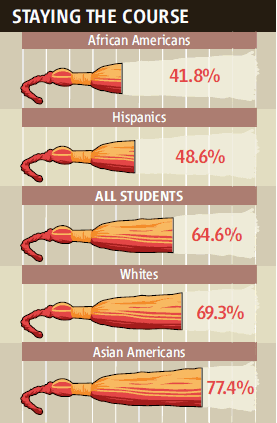|
|
|
|
|
|
|
News & Views item - June 2009 |
![]() Low Socio-Economic Status and Higher Education in Science, Technology,
Engineering or Mathematics. (June 13, 2009)
Low Socio-Economic Status and Higher Education in Science, Technology,
Engineering or Mathematics. (June 13, 2009)
Australia's 2009/10 federal budget, brought down on May 12, allocates $206 million over two years in performance funding to improve teaching quality, participation, student engagement and completion rates and institutions that attract and retain low socio-economic-status students will be rewarded with $325 million over four years while universities will be given $108 million over four years to build long-term partnerships with schools in disadvantaged areas to promote the benefits of higher education.
 Overall rates of retention of US university students who begin as science majors and actually graduate with a STEM degree. |
Just how this is to be undertaken isn't specified but undoubtedly plans already exist or are in advanced planning by universities to take advantage of the the promised funds.
It's of interest the this week the journal Science has devoted a couple of pages to the matter of Minority Retention Rates in Science [which] Are Sore Spot for Most [US] Universities. The article by Robert Koenig analyses the efforts of the University of Maryland, Baltimore County (UMBC) and the University of California, Berkeley (UC, Berkeley) who, over a number of years, have attempted to redress the problem of low retention rates of minorities and have amassed data sets on their results.
Mathematician Freeman Hrabowski, UMBC's president, told Mr Koenig: "Most institutions have the intent to improve retention rates; they simply don't know how to do it."
It is his university which houses the Meyerhoff Scholars program, backed by Baltimore philanthropists Robert and Jane Meyerhoff. Their family foundation supplies two-thirds of the program's $3.5 million budget for 2008–09. The program, begun in 1989, has tried to address the failure of U.S. higher education of the high attrition rates among minority students (predominantly African-Americans and Hispanics) who enter UMBC with an interest in science, technology, engineering, and mathematics (STEM).
The approach taken by the Meyerhoff Scholars program is to recruit "high-achieving high-school seniors, two-thirds of them underrepresented minorities, give them generous financial aid, use a summer bridge program to create group cohesion, plunge them quickly into research, and surround them with mentors", and while the program is expensive, the results according to Mr Koenig are impressive: "Seven of eight graduates (more than 650) have earned degrees in STEM fields, and they have gone on to receive 53 Ph.D. degrees, 74 medical degrees, and 21 combined degrees. Hrabowski says that makes UMBC, with an enrollment that is 14% African-American and 3% His-panic, 'one of the few predominantly white universities producing significant numbers of African-Americans who go on to get Ph.D.s.'"
UC, Berkeley has followed a different approach; it founded the Biology Scholars Program sixteen years ago, and Mr Koenig notes: "Since 2000, 69% of its 650 students have graduated within 4 years, topping the 61% rate for the rest of the student body. Among African-American students—some of whom take more than 4 years to complete their studies—scholars have a 93% graduation rate versus 73% for their nonprogram peers. Only 0.15% of biology scholars are dismissed for poor academic performance, notes evolutionary biologist John Matsui, who directs the program, compared with 3.5% for all UC Berkeley undergraduates. The program's annual budget of $1.5 million comes from the Howard Hughes Medical Institute (HHMI) and, since 2004, the Gordon and Betty Moore Foundation."
These two programs are standout exceptions but it appears progress is beginning.
In 2004 Louisiana State University set up LA-STEM which, while similar to that of the Meyerhoff Scholars, has access to a much smaller budget. this month it will graduate 46 students with a retention rate of 90%, but LSU's vice chancellor, analytical chemist Isaiah Warner says: "we are far behind Meyerhoff in terms of getting and measuring results." And one of the problems is obtaining adaquate and appropriate data on which to base future methodology.
At the University of Michigan Derek Scott, director of UM's multicultural engineering program told Mr Koenig: "Our challenge was, how could we put a Meyerhoff-like model to work in a large research institution?" While in 2007, Cornell University instituted Berkeley's Biology Scholars Program. It "takes in 20 to 25 first-year students each year, offering them mentoring, special events, and research opportunities. Virologist Laurel Southard, who directs the department's undergraduate research and outreach is seeking outside support to supplement a small budget provided by the department and the vice provost's office".
And finally the Science article describes the effort that Harvard University has undertaken The department of biology: "offers a Howard Hughes Medical Institute–sponsored program that each year enrolls about 40 freshmen students from disadvantaged backgrounds. 'We stick with them for all 4 years,' says biologist Robert Lue. 'They are assigned to a faculty lab and mentored by faculty and others.' In 2006, Harvard started a wider effort—the Program for Research in Science and Engineering—that offers summer research opportunities to undergraduates from all of the sciences. Lue says that the number of women and under represented minorities majoring in the life sciences has risen by 16% over the past 4 years. He's now analyzing the program's impact on attrition rates."